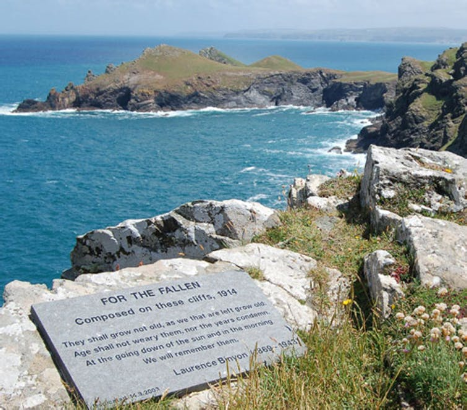On an autumn day in 1914 Laurence Binyon sat on a cliff in North Cornwall, somewhere between Pentire Point and the Rump. It was less than seven weeks after the outbreak of war, but British casualties were mounting. Long lists of the dead and wounded were appearing in British newspapers. With the British Expeditionary Force in retreat from Mons, promises of a speedy end to war were fading fast.
Against this backdrop Binyon, then Assistant Keeper of Prints and Drawings at the British Museum, sat to compose a poem that Rudyard Kipling would one day praise as “the most beautiful expression of sorrow in the English language”.
Against this backdrop Binyon, then Assistant Keeper of Prints and Drawings at the British Museum, sat to compose a poem that Rudyard Kipling would one day praise as “the most beautiful expression of sorrow in the English language”.

“For the Fallen”, as Binyon called his poem, was published in The Times on 21 September 1914. “The poem grew in stature as the war progressed”, Binyon’s biographer John Hatcher observed, “accommodating itself to the scale of the nation’s grief”.
Nearly a century on, Binyon’s poem endures as a dignified and solemn expression of loss. The fourth stanza - lifted to prominence as “The Ode of Remembrance” - is engraved on cenotaphs, war memorials and headstones in war cemeteries throughout the English-speaking world. Recited at Remembrance services in Britain, Canada, Australia and New Zealand, the poem serves as a secular prayer:
Nearly a century on, Binyon’s poem endures as a dignified and solemn expression of loss. The fourth stanza - lifted to prominence as “The Ode of Remembrance” - is engraved on cenotaphs, war memorials and headstones in war cemeteries throughout the English-speaking world. Recited at Remembrance services in Britain, Canada, Australia and New Zealand, the poem serves as a secular prayer:
They shall grow not old, as we that are left grow old:
Age shall not weary them, nor the years condemn;
At the going down of the sun, and in the morning,
We will remember them.
Age shall not weary them, nor the years condemn;
At the going down of the sun, and in the morning,
We will remember them.
On an autumn day in 1914 Laurence Binyon sat on a cliff in North Cornwall, somewhere between Pentire Point and the Rump. It was less than seven weeks after the outbreak of war, but British casualties were mounting. Long lists of the dead and wounded were appearing in British newspapers. With the British Expeditionary Force in retreat from Mons, promises of a speedy end to war were fading fast.
Against this backdrop Binyon, then Assistant Keeper of Prints and Drawings at the British Museum, sat to compose a poem that Rudyard Kipling would one day praise as “the most beautiful expression of sorrow in the English language”.
“For the Fallen”, as Binyon called his poem, was published in The Times on 21 September 1914. “The poem grew in stature as the war progressed”, Binyon’s biographer John Hatcher observed, “accommodating itself to the scale of the nation’s grief”.
Against this backdrop Binyon, then Assistant Keeper of Prints and Drawings at the British Museum, sat to compose a poem that Rudyard Kipling would one day praise as “the most beautiful expression of sorrow in the English language”.
“For the Fallen”, as Binyon called his poem, was published in The Times on 21 September 1914. “The poem grew in stature as the war progressed”, Binyon’s biographer John Hatcher observed, “accommodating itself to the scale of the nation’s grief”.
Source: https://theconversation.com/lest-we-forget-binyons-ode-of-remembrance-13642